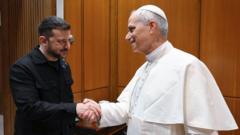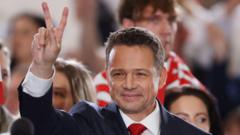The papal conclave began this morning following the passing of Pope Francis, with the cardinals promising to uphold the church's mission during their sequestered voting process.
**Conclave Underway: Cardinals Gather to Select New Pope Amid Uncertainty in the Catholic Church**

**Conclave Underway: Cardinals Gather to Select New Pope Amid Uncertainty in the Catholic Church**
As 133 cardinals sequester in the Sistine Chapel, the Roman Catholic Church faces a critical juncture in its history, looking for direction in today’s complex world.
The long-awaited papal conclave has commenced today in the Sistine Chapel, with 133 cardinals convening to determine the successor of Pope Francis, who passed away just over two weeks ago. This conclave represents the first time in a decade that the cardinals have gathered to elect a new pope, signaling a pivotal moment for the 1.4 billion members of the Roman Catholic Church.
As the grand wooden doors to the chapel closed behind them, the cardinals began their solemn duties amid a swirl of historical significance and immediacy. Prior to this moment, they gathered for a final Mass at St. Peter’s Basilica – their last public event before entering complete seclusion. Once inside the chapel, they took an oath to adhere strictly to the rules governing the conclave, which enforces a promise of total secrecy throughout the election process amid the backdrop of Michelangelo’s masterpieces.
The situation surrounding this assembly of cardinals is particularly fraught, as they grapple with divisions within the Church—between progressive elements advocating for openness and inclusion and conservative factions desiring a return to traditional values. This division complicates predictions about the outcome and may potentially shape future church policy. Experts indicate the possibility that many of the participating cardinals may be unfamiliar with one another, marking a departure from the more unified selection processes of the past.
Voting is expected to commence soon, with initial outcomes possibly revealing how the cardinals lean in their allegiances—towards a future aligned with the inclusive policies of Francis, or a more conservative approach. If the initial vote does not yield an outright majority, the cardinals will continue to deliberate and vote until they achieve the required two-thirds consensus.
Amidst this historic occasion, speculation among observers has generated excitement over potential candidates who could rise to lead the Church through tumultuous waters. The votes will be cast under the watchful gaze of the intricate frescoes that adorn the chapel, imbuing this election with a profound sense of tradition and responsibility.
As the world waits for the eventual appearance of white smoke, signaling the Church’s choice of a new leader, the unfolding drama of the papal conclave promises to encapsulate the hopes and challenges facing the Catholic Church in a rapidly evolving global landscape.
As the grand wooden doors to the chapel closed behind them, the cardinals began their solemn duties amid a swirl of historical significance and immediacy. Prior to this moment, they gathered for a final Mass at St. Peter’s Basilica – their last public event before entering complete seclusion. Once inside the chapel, they took an oath to adhere strictly to the rules governing the conclave, which enforces a promise of total secrecy throughout the election process amid the backdrop of Michelangelo’s masterpieces.
The situation surrounding this assembly of cardinals is particularly fraught, as they grapple with divisions within the Church—between progressive elements advocating for openness and inclusion and conservative factions desiring a return to traditional values. This division complicates predictions about the outcome and may potentially shape future church policy. Experts indicate the possibility that many of the participating cardinals may be unfamiliar with one another, marking a departure from the more unified selection processes of the past.
Voting is expected to commence soon, with initial outcomes possibly revealing how the cardinals lean in their allegiances—towards a future aligned with the inclusive policies of Francis, or a more conservative approach. If the initial vote does not yield an outright majority, the cardinals will continue to deliberate and vote until they achieve the required two-thirds consensus.
Amidst this historic occasion, speculation among observers has generated excitement over potential candidates who could rise to lead the Church through tumultuous waters. The votes will be cast under the watchful gaze of the intricate frescoes that adorn the chapel, imbuing this election with a profound sense of tradition and responsibility.
As the world waits for the eventual appearance of white smoke, signaling the Church’s choice of a new leader, the unfolding drama of the papal conclave promises to encapsulate the hopes and challenges facing the Catholic Church in a rapidly evolving global landscape.




















